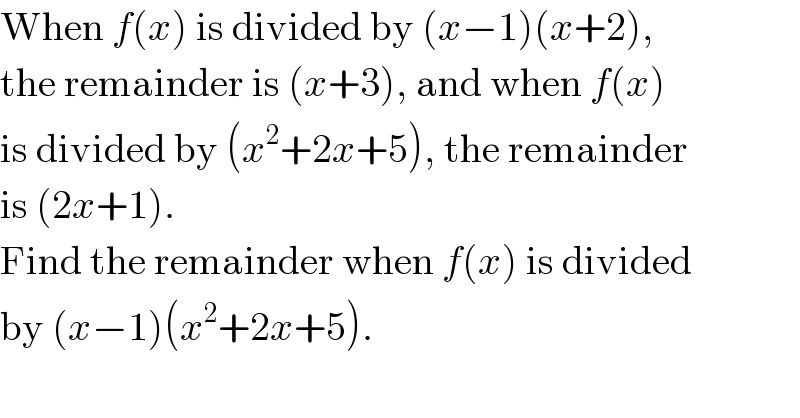
Question Number 120091 by ZiYangLee last updated on 29/Oct/20

$$\mathrm{When}\:{f}\left({x}\right)\:\mathrm{is}\:\mathrm{divided}\:\mathrm{by}\:\left({x}−\mathrm{1}\right)\left({x}+\mathrm{2}\right),\: \\ $$$$\mathrm{the}\:\mathrm{remainder}\:\mathrm{is}\:\left({x}+\mathrm{3}\right),\:\mathrm{and}\:\mathrm{when}\:{f}\left({x}\right) \\ $$$$\mathrm{is}\:\mathrm{divided}\:\mathrm{by}\:\left({x}^{\mathrm{2}} +\mathrm{2}{x}+\mathrm{5}\right),\:\mathrm{the}\:\mathrm{remainder} \\ $$$$\mathrm{is}\:\left(\mathrm{2}{x}+\mathrm{1}\right). \\ $$$$\mathrm{Find}\:\mathrm{the}\:\mathrm{remainder}\:\mathrm{when}\:{f}\left({x}\right)\:\mathrm{is}\:\mathrm{divided} \\ $$$$\mathrm{by}\:\left({x}−\mathrm{1}\right)\left({x}^{\mathrm{2}} +\mathrm{2}{x}+\mathrm{5}\right). \\ $$
Answered by TITA last updated on 29/Oct/20
![for a given polynomial p(x)=f(x)q(x)+r where r is the remainder if r=o then q(x) divids p(x) let f(x)=p(x)(x−1)(x+2)+x+3.......(1) f(x)=p(x)(x^2 +2x+5)+2x+1........(2) (1)−(2)⇒ 0=p(x)[x^2 +x−2−(x^2 +2x+5)]+2−x ⇒x−2=p(x)[−x−7] ence p(x)=((2−x)/(x+7)) since f(x)=p(x)q(x)+r hence r=f(x)−p(x)q(x) (2)⇒f(x)=(((2−x)/(x+7)))(x^2 +2x+5)+2x+1 ⇒r=[(((2−x)/(x+7)))(x^2 +2x+5)+2x+1]−[(((2−x)/(x+7)))(x−1)(x^2 +2x+5)] ⇒r=(((2−x)/(x+7)))(x^2 +2x+5)[2−x] +2x+1 ⇒r=(((2−x)^2 (x^2 +2x+5))/(x+7))+2x+1](Q120099.png)
$$\mathrm{for}\:\mathrm{a}\:\mathrm{given}\:\mathrm{polynomial}\:\mathrm{p}\left(\mathrm{x}\right)=\mathrm{f}\left(\mathrm{x}\right)\mathrm{q}\left(\mathrm{x}\right)+{r} \\ $$$${where}\:{r}\:{is}\:{the}\:{remainder} \\ $$$$\mathrm{if}\:\mathrm{r}=\mathrm{o}\:\mathrm{then}\:\mathrm{q}\left(\mathrm{x}\right)\:\mathrm{divids}\:\mathrm{p}\left(\mathrm{x}\right) \\ $$$$\mathrm{let}\:\mathrm{f}\left(\mathrm{x}\right)=\mathrm{p}\left(\mathrm{x}\right)\left(\mathrm{x}−\mathrm{1}\right)\left(\mathrm{x}+\mathrm{2}\right)+\mathrm{x}+\mathrm{3}.......\left(\mathrm{1}\right) \\ $$$$\mathrm{f}\left(\mathrm{x}\right)=\mathrm{p}\left(\mathrm{x}\right)\left({x}^{\mathrm{2}} +\mathrm{2}{x}+\mathrm{5}\right)+\mathrm{2}{x}+\mathrm{1}........\left(\mathrm{2}\right) \\ $$$$\left(\mathrm{1}\right)−\left(\mathrm{2}\right)\Rightarrow\:\mathrm{0}={p}\left({x}\right)\left[{x}^{\mathrm{2}} +{x}−\mathrm{2}−\left({x}^{\mathrm{2}} +\mathrm{2}{x}+\mathrm{5}\right)\right]+\mathrm{2}−{x} \\ $$$$\Rightarrow{x}−\mathrm{2}={p}\left({x}\right)\left[−{x}−\mathrm{7}\right] \\ $$$${ence}\:{p}\left({x}\right)=\frac{\mathrm{2}−{x}}{{x}+\mathrm{7}} \\ $$$${since}\:{f}\left({x}\right)={p}\left({x}\right){q}\left({x}\right)+{r}\: \\ $$$${hence}\:{r}={f}\left({x}\right)−{p}\left({x}\right){q}\left({x}\right) \\ $$$$\left(\mathrm{2}\right)\Rightarrow{f}\left({x}\right)=\left(\frac{\mathrm{2}−{x}}{{x}+\mathrm{7}}\right)\left({x}^{\mathrm{2}} +\mathrm{2}{x}+\mathrm{5}\right)+\mathrm{2}{x}+\mathrm{1} \\ $$$$\Rightarrow{r}=\left[\left(\frac{\mathrm{2}−{x}}{{x}+\mathrm{7}}\right)\left({x}^{\mathrm{2}} +\mathrm{2}{x}+\mathrm{5}\right)+\mathrm{2}{x}+\mathrm{1}\right]−\left[\left(\frac{\mathrm{2}−{x}}{{x}+\mathrm{7}}\right)\left({x}−\mathrm{1}\right)\left({x}^{\mathrm{2}} +\mathrm{2}{x}+\mathrm{5}\right)\right] \\ $$$$\Rightarrow{r}=\left(\frac{\mathrm{2}−{x}}{{x}+\mathrm{7}}\right)\left({x}^{\mathrm{2}} +\mathrm{2}{x}+\mathrm{5}\right)\left[\mathrm{2}−{x}\right]\:+\mathrm{2}{x}+\mathrm{1} \\ $$$$\Rightarrow{r}=\frac{\left(\mathrm{2}−{x}\right)^{\mathrm{2}} \left({x}^{\mathrm{2}} +\mathrm{2}{x}+\mathrm{5}\right)}{{x}+\mathrm{7}}+\mathrm{2}{x}+\mathrm{1} \\ $$
